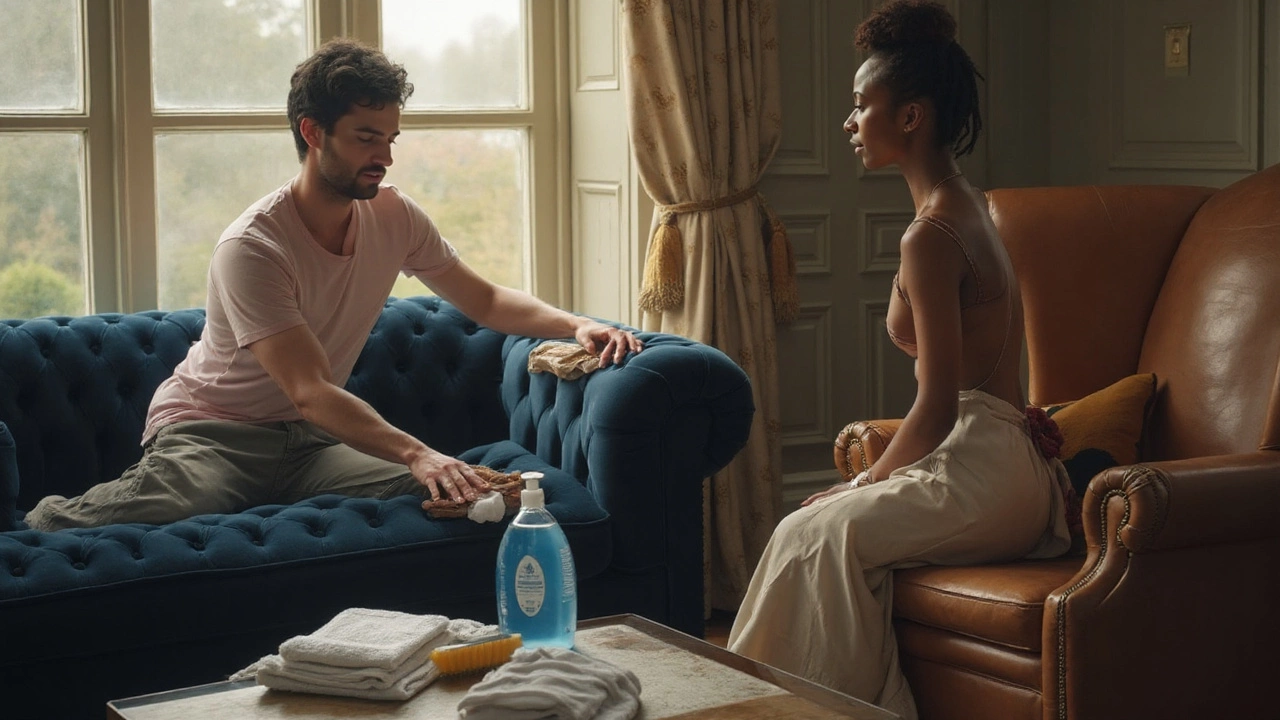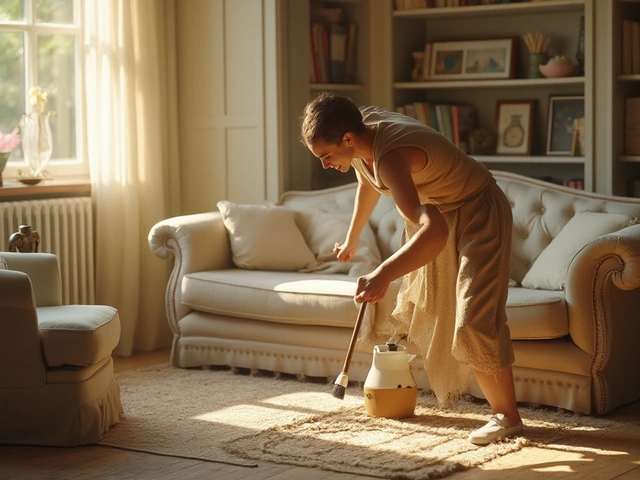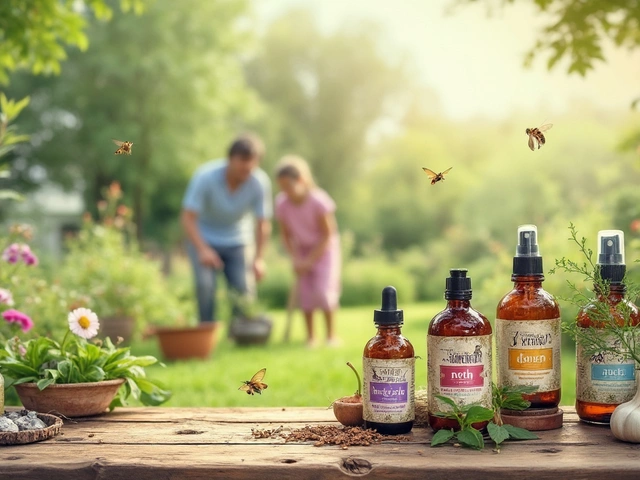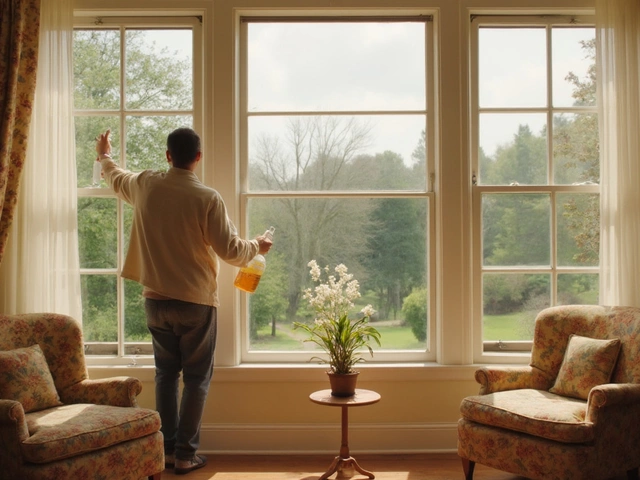If you’re staring at a greasy mark on the sofa and wondering if the same blue bottle that de-greases your pans can fix it-yes, Dawn can help. But it’s not a universal upholstery cleaner. Used right, it lifts oils and everyday grime on water-safe fabrics. Used wrong, it leaves residue, water rings, or even colour bleed. I live in Brighton with two kids (Damon and Callum) and a mud-loving dog (Sable), so my sofas see action. Here’s what actually works at home and what professional standards say.
Is Dawn Dish Soap Safe for Upholstery? The Short Answer
TL;DR
- Yes-Dawn works on water-cleanable fabrics (codes W or WS) for greasy, food, and general dirt.
- No-avoid on solvent-only (S), vacuum-only (X), leather, suede, silk, wool, viscose/rayon, and linen blends unless a pro okays it.
- Use a tiny amount: 1/4 teaspoon per 1 cup (240 ml) warm water. Rinse with plain water. Dry fast.
- Great as a pre-spotter. Don’t put dish soap in an extractor-too foamy. Use low-foam upholstery shampoo.
- Patch test first. Watch for dye transfer, rings, or fuzzing. Stop if anything looks off.
Here’s the simple truth: dish soap is designed to emulsify oils. Upholstery gets body oils, food, and hand marks-so there’s a neat overlap. Dawn (mildly alkaline, around pH 9 per P&G’s safety data) is strong on grease. But upholstery isn’t a non-stick pan. Many fabrics have delicate dyes, natural fibres, or thin backings that don’t like moisture or aggressive surfactants. The Institute of Inspection Cleaning and Restoration Certification (IICRC S300) stresses testing, minimal moisture, controlled detergents, and thorough rinsing to prevent damage and rapid resoiling.
So yes to quick, targeted spot cleaning on W/WS fabrics, used sparingly. No to soaking cushions, scrubbing hard, or using it on the wrong materials. When in doubt, treat Dawn as a light pre-wash step, then rinse and dry like you’re racing the clock.
If you’re in the UK and can’t find Dawn easily, Fairy Liquid is the closest everyday alternative (same manufacturer). The guidance below applies the same way.
Step-by-Step: Clean Upholstery with Dawn the Right Way
Goal: lift the mark fast, leave nothing behind, and avoid spreading the stain or making a ring. Less soap, more patience.
-
Check the tag and do a patch test. Look for cleaning codes: W (water OK), WS (water or solvent), S (solvent only), X (vacuum only). Many UK sofas skip codes, so assume nothing. Test a hidden spot with your mix: dab, wait 5 minutes, blot. Stop if you see dye bleed, fuzzing, or a ring.
-
Mix a weak solution. 1/4 teaspoon Dawn per 1 cup (240 ml) warm water. That’s it. If you’re pouring more than a teardrop, it’s too much. Too many suds = residue = faster re-soiling.
-
Pre-blot the stain dry. Use a white microfiber cloth to pull up liquid or loose soil. Always blot; don’t rub. Work from the outside of the stain in.
-
Apply with a cloth, not by pouring. Lightly dampen a clean cloth with your Dawn mix. Dab the stain. For greasy marks, a soft brush can help-but keep it gentle.
-
Pause and lift. Give it 60-90 seconds to emulsify oils. Blot with a dry cloth. Rotate to a clean part of the cloth so you’re lifting, not smearing.
-
Rinse the area. Use another cloth with plain warm water. Dab to flush out soap. This step matters. Detergent residue attracts dirt and can leave a dull halo.
-
Blot dry and speed up airflow. Press with dry towels. Prop cushions upright. Run a fan. Fast drying limits water marks and prevents browning on cellulosic fibres (cotton, linen, viscose).
-
Groom the nap. On fabrics with a pile (velvet, chenille), lightly brush fibres the same direction as the surrounding area while damp to avoid shading.
How much solution is enough? For a palm-sized spot, a tablespoon of mix usually does it. If you’re soaking through to the cushion core, you’re using too much.
| Use case | Suggested ratio | Approx. solution needed | Notes |
|---|---|---|---|
| Greasy hand mark | 1/4 tsp Dawn : 1 cup water | 1-2 tbsp | Blot, then rinse thoroughly |
| Food drip (sauce/oil) | 1/4 tsp Dawn : 1 cup water | 2-3 tbsp | Lift solids first; keep moisture surface-level |
| General armrest grime | 1/4 tsp Dawn : 1 cup water | 1/4-1/2 cup | Work in small sections; rinse and towel-dry each area |
| Pre-treat before extractor | 1/4 tsp Dawn : 1 cup water | Light mist only | Do not add to machine tank; use low-foam shampoo there |
Why the obsession with rinsing? The IICRC emphasizes that leftover detergents cause quick resoiling. You’ll think the stain came back. It’s just dust sticking to sticky residue.
Two big don’ts:
- Never mix dish soap with bleach or strong oxidizers. Chemistry rules apply, and you don’t want chlorinated byproducts in your living room.
- Don’t scrub hard on delicate weaves. If the fabric pills under your cloth, stop and rethink.

When Dawn Works, When It Doesn’t: Fabrics, Stains, and Smart Alternatives
This is the part that saves sofas. Use this like a quick decision tree before you touch the bottle.
- Fabric code W or WS: Dawn mix is usually safe for small spots. Rinse. Dry fast.
- Fabric code S: Skip water. Use a solvent upholstery cleaner or isopropyl alcohol (70-90%) on a cloth. Ventilate well.
- Code X: Vacuum only. Call a pro if stained.
- Leather/vinyl: Use a pH-balanced leather cleaner; dish soap can strip finishes.
- Natural fibres (wool, silk, linen) and viscose/rayon: High risk of water rings, dye bleed, shrinkage. If you must, micro-doses and immediate drying, but better to use specialty, WoolSafe-approved products or a pro.
Stain-by-stain playbook (what I use at home and what labs/pro standards back up):
- Grease/oil (best use for Dawn): Dish soap shines here (anionic surfactants emulsify oils-this is its core job). Dab Dawn mix, wait a minute, blot, rinse. This saved our sofa after Damon parked a buttered crumpet on it.
- Tomato sauce/curry: Tackle the oil with Dawn mix first. For remaining dye, a tiny bit of oxygen bleach (on W/WS white or colourfast fabrics only) can help; test first. Rinse well.
- Coffee/tea: Blot, then Dawn mix. If a yellow cast remains, add a drop of white vinegar to your rinse water for the tannins-test on dye stability.
- Chocolate/ice cream: These are oil + protein. Use Dawn mix first, then follow with an enzyme cleaner (labelled for upholstery) for lingering protein. Enzymes need time-5-10 minutes-then rinse.
- Blood/milk/vomit (protein): Cold water first, then enzyme cleaner. Dawn is secondary here. Warm water sets protein; keep it cool.
- Pet urine: Use an enzyme cleaner designed for urine. Dish soap won’t remove odor-causing bacteria fully. After enzyme step and rinse, bicarb (dry) can help deodorise-vacuum after it dries. Sable, I’m looking at you.
- Ink/marker: Skip Dawn. Blot with isopropyl alcohol on a cotton bud, then water rinse. Work slow; ink moves.
- Mud: Let dry, vacuum, then use Dawn mix for any leftover clay/oil.
- Red wine: Blot fast, flush with cool water. Dawn mix for any greasy undertones from snacks; for dyes, a fabric-safe oxidiser can help on W/WS only.
UK note: If you can’t source Dawn, Fairy Liquid works similarly. For wool furnishings, look for the WoolSafe logo on products. Wool fibres dislike alkalinity and over-wetting; the WoolSafe programme backs pH-appropriate options.
Machine cleaning? Read this carefully:
- Don’t put dish soap in a carpet/upholstery extractor (BISSELL/Vax manuals warn about foaming). You’ll get a bubble party and poor extraction.
- Do pre-spot with your Dawn mix on greasy spots, then extract with a low-foam upholstery shampoo. Rinse with plain water pass.
- Dry fast: windows open, fan on. Cushions upright. Speed is your friend.
| Fabric / Code | Can I use Dawn? | Better option | Risk if wrong |
|---|---|---|---|
| Polyester, microfiber (W/WS) | Yes, light spotting | Low-foam upholstery shampoo for larger areas | Residue, water rings if not rinsed |
| Cotton/linen (often WS) | Careful micro-spotting only | Neutral pH upholstery soap; pro cleaning for big spills | Browning, shrinkage, dye bleed |
| Wool, silk | Prefer not | WoolSafe-approved products; pro service | Fibre damage, felting |
| Viscose/rayon | No (high risk) | Professional dry solvent cleaning | Water marks, distortion |
| Leather/vinyl | No | pH-balanced leather cleaner, conditioner | Finish stripping, cracking |
| Code S (solvent only) | No | Solvent cleaner/IPA spotter | Rings, dye bleed, texture change |
One more nuance: Some microfibres (polyester) handle water well but hold onto suds. Rinse longer than you think and towel-dry thoroughly. After it dries, brush the nap to restore the look.
About the product itself: according to P&G’s safety data sheets, dish liquids like Dawn Ultra are mildly alkaline and packed with surfactants. That’s why a single drop goes far. It’s also why a heavy hand backfires on fabric-foams up, stays put, and grabs new soil. Use the smallest amount that gets the job done, and rinse, rinse, rinse.
Checklists, FAQs, and Fixes (So You Don’t Make It Worse)
Bookmark these quick references. They save time when you’re mid-spill.
Fast checklist before you start
- Find your fabric code or do a quick colourfast test in a hidden spot.
- Mix weak: 1/4 tsp Dawn + 1 cup warm water. If it looks sudsy, it’s too strong.
- Blot dry soil first. Apply with a cloth, never pour directly.
- Give it a minute, then blot to lift.
- Rinse with plain water until no suds transfer to a cloth.
- Dry fast with airflow. Groom the fibres while damp if it’s a napped fabric.
Common pitfalls
- Using too much soap. Residue attracts dirt and creates halos.
- Skipping the rinse. If you have time to apply, you have time to rinse.
- Over-wetting. Water that reaches the cushion core can wick stains back up and leave rings.
- Scrubbing hard. You’ll rough up the fibres and create a shiny patch.
- Mixing with bleach. Just don’t.
Mini-FAQ
- Is Dawn safe on all upholstery? No. Stick to W or WS fabrics and small spots. Avoid S and X codes, leather, wool, silk, viscose/rayon, and linen blends.
- What ratio is best? 1/4 teaspoon per 1 cup (240 ml) warm water for spot cleaning. For very light dusting, halve the soap again.
- Do I need to rinse? Yes. Wipe with plain water until your cloth comes up clean. Residue causes quick re-soiling.
- Can I use it in my BISSELL or Vax? No. Dish soap foams too much. Use a dedicated low-foam upholstery formula in the tank; pre-spot with the Dawn mix if needed.
- What about odours? Dish soap removes oily residues but not deep odours. Use an enzyme cleaner for urine/milk; baking soda after drying can help surface smells.
- Is Fairy Liquid the same? It fills the same role in the UK. Method and cautions are the same.
Quick decision guide
- If the stain is oily/greasy on a W/WS fabric → Use Dawn dish soap upholstery mix, then rinse.
- If it’s protein (milk, blood, vomit) → Cold water + enzyme cleaner. Dawn only after enzymes.
- If it’s dye/ink → Alcohol-based spotter first; then water rinse.
- If the fabric is S or X → No water. Use solvent cleaner or call a pro.
Troubleshooting
- I see a ring after it dried. Re-wet the entire panel lightly with plain water, then blot outward to the edge so the drying line isn’t sharp. Add a tiny bit of fabric-safe acidic rinse (or a splash of white vinegar in water) on cotton/linen only. Dry with strong airflow.
- The stain came back overnight. That’s wicking. The deeper cushion is contaminated. Repeat, using much less moisture, and press dry towels under and over the area while it dries to pull moisture up.
- The fabric looks dull where I cleaned. Residue. Rinse again with plain water, then a light wipe with a microfiber dampened in distilled water. Dry and groom the nap.
- Still greasy after two rounds. You may need a solvent step. On W/WS fabrics, a small amount of isopropyl alcohol on a cloth can chase leftover oils-test first. Then a quick water rinse.
- Bad smell after cleaning. That’s slow drying. Re-wet lightly, extract moisture with towels, then run a fan/heat on low. For organic odours, finish with an enzyme treatment once the area is merely damp.
When to call a pro
- Large spills across multiple cushions.
- Delicate fibres (wool, silk, viscose) or designer fabrics with unknown finishes.
- Smoke/soot contamination (needs specialised processes).
- Stains that keep wicking back even after careful attempts.
Real-life snapshots
- Pizza-night grease on polyester microfiber: One pass with the weak Dawn mix, a careful rinse, and a fan-gone in 20 minutes. No halo.
- Latte spill on a cotton-linen cushion: Dawn mix for the milk fats, then an enzyme cleaner. I kept it surface-only and dried fast. No browning.
- Muddy paw prints from Sable: Let the mud dry, vacuum, tiny Dawn mix for leftover grime, rinse, brush the nap. Easy win.
Why this works
It’s part chemistry, part restraint. Dish soap’s surfactants surround oils and let water carry them away. Upholstery needs that, but in micro doses, with good rinsing, and minimal moisture so you don’t disturb dyes or underlayers. Standards bodies like the IICRC call this “controlled cleaning”-targeted, tested, and reversible. Follow that mindset, and your sofa looks fresh without the side effects.
If you remember one thing: tiny amount of soap, thorough rinse, fast dry. That’s the difference between a quick fix and a long-term stain magnet.




